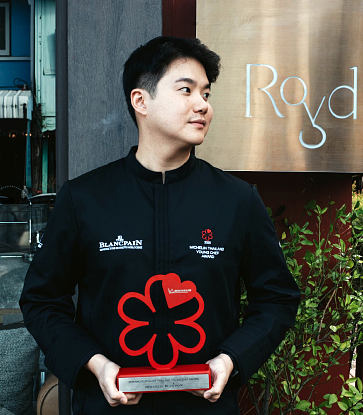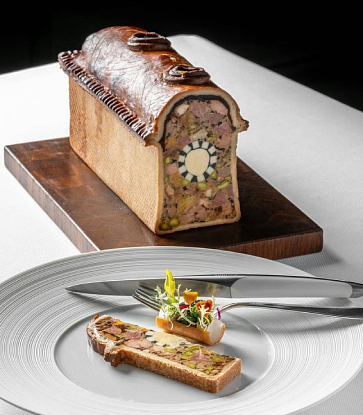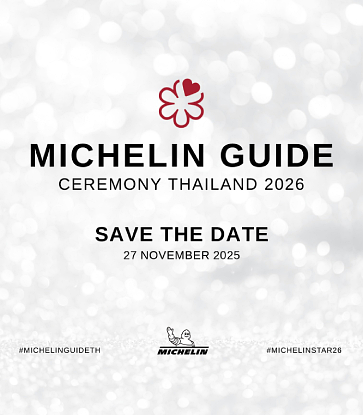Even the most casual observer of food trends will have noticed the skyrocketing interest in plant-based dining over the past decade or so. Oat milk and almond milk have gone from relatively obscure health foods to a critical component of any supermarket's dairy cases, and high-quality plant-based burgers have become a fast food staple. Based on food-industry trends, The Economist declared 2019 to be the “year of the vegan”. Furthermore, even non-vegetarian consumers have shown an increasing interest in plant-based cuisine, following the publication of books like Michael Pollan's The Omnivore's Dilemma, in which he famously prescribed that we should “eat food, not too much, mostly plants.”
As is so often the case, the highest of the high-end were well ahead of broader trends. In 2001, Chef Alain Passard shocked the culinary world by switching his three MICHELIN Star Paris institution Arpège to a fully vegetarian menu in 2001, with only a slow return of animal protein and courses remaining primarily plant-based. Same goes with Chef Daniel Humm’s three MICHELIN Star Eleven Madison Park ten years later.
Of course, for the vast majority of human history, diets were primarily plant-based, and that remains the case in much of the developing world. Indeed, the term “plant-based diet” was coined by Cornell University biochemist T. Colin Campbell, who led research into health and diets in rural China in a 20-year epidemiological study, in his bestselling book The China Study, where he advocated a whole-food, mostly-plant diet to prevent chronic illness.
Much ink has been spilled describing the health and environmental benefits of a plant-based diet. As a result, perhaps too much emphasis has been placed on ethical and nutritional correctness, and not enough on sheer pleasure. When mothers exhort their children to eat their vegetables, they do so for their children's well-being, not for joy, and unfortunately, that attitude has carried over into adulthood for far too many.

“There are a lot of diners who say our vegetarian menu is better than our non-vegetarian,” says Chef Deepanker Khosla (or Chef DK, as he is almost universally known). His one MICHELIN star restaurant Haoma has pioneered a sustainability-based approach on the far end of a quiet soi in Bangkok's otherwise frenetic Asoke neighbourhood, earning it a MICHELIN Green Star in 2022, making it the city's first restaurant to do so.
Even the most carnivorous travellers who find themselves in India often comment on how they don’t feel deprived when dining with the vegetarian options that they encounter. Given that the country has hundreds of millions of vegetarians – perhaps as many as 40% of the population -- one can easily see why.
Chef DK's story starts in the North Indian city of Allahabad, where he was raised in a vegetarian household, with even stricter rules for fasting days, on which no alliums (like onions or garlic) or nightshades (like tomatoes and peppers) were permitted. However, as Chef DK explains, that was hardly a restriction. “The river, you have glacial melt floods that create alluvial floodplains. You can plant anything in that region... On this side of the city runs the Ganges, on this side runs the Yamuna... it floods all of the outskirts of the city, and according to the archaeologists, that is the most fertile soil anywhere on the planet.” In this agricultural wonderland, he notes, “peak summer is the sweetest mango on the planet, and frost gives us the best green leafy vegetables you can imagine.”
With this kind of background, one can imagine that at Haoma vegetables take centre stage and are treated with the same reverence that a chef might treat an A5 Wagyu steak. “I think we do not have to take the pains of trying to make our lamb compete with our spinach. They have their own identity.” In fact, the present star entree is jackfruit – a dish that brings back fond memories of Chef DK's father waiting for neighbourhood weddings so he could get a bowl of jackfruit curry. “If you come to Haoma and you order from the non-vegetarian menu, 40% of the menu is still vegetarian. And that's how it should be.”
The key, Chef DK argues, is – much like Michael Pollan would argue – balance. “As Indians, we have always agreed. There will be a chicken curry on the table, but there will also be cucumbers, tomatoes, and onions with coriander to eat as a salad. Then there will be a sabzi, like a spinach or a palak paneer. Then there will be high-protein dal... there will be carbohydrates.”
Where Chef DK parts from a lot of the current received wisdom is when it comes to the boom in plant-based dining. After all, those same soy products in the supermarket freezer are largely made by the same corporations that sell industrially produced meat. “Sustainability in cuisine, especially plant-based for example, is a massive marketing gimmick. Saying that plant-based cuisine is more sustainable is wrong.” To demonstrate, he pulls up a video of his farm, with free-range chickens joyfully clucking around the base of a mango tree. “This is sustainability to me.”
India is not the only country to have a strong tradition of vegetarian cooking. In Japan, for instance, shojin ryori, or Buddhist temple cuisine, has been a major culinary tradition since the Middle Ages, as part of an upsurge in the practice of Zen. Like Thailand's own jeh cuisine, shojin ryori is completely vegan and totally forbids the use of alliums, which are said to inflame the senses. Needless to say, these restrictions would present even the most talented chefs with a serious challenge.

However, Chiang Mai might be a logical place for a restaurant inspired by shojin ryori. With its reputation as a hippie hub, boasting the second-most vegan restaurants per capita of any city in the world, it is fertile ground. And at the foot of Doi Suthep, the Osaka-born husband-and-wife team of Yuki and Keiko Makino have established the MICHELIN-listed Aeeen Japanese Vegan (Neo Shokudo), a.k.a. Neo-Shokudo (with “Aeeen” being the sound of the iconic laugh of Japanese comedian Ken Shimura, and “shokudo” being a Japanese term for a simple, casual restaurant). Their cuisine is inspired by shojin ryori – “inspired,” because the Makinos have no trouble using alliums, with a strong focus on Japanese-style fermentation.
What started as a series of cooking experiments and bicycle-delivery services for plant-based bento in Japan has turned into a full-scale restaurant and shop. After moving to Chiang Mai more or less on a whim 10 years ago, they set up their business, starting by selling handmade tofu and natto (a famously strong-smelling and famously divisive fermented soybean product). Now they offer a full line of fermented products and operate Aeeen just three days a week, Friday through Sunday.
For Keiko, the restrictions are a conduit for creativity. She says, “I want to create every day. If I use animal products, it's so easy for me... if I only use vegetables, I need to think.”
And Aeeen's menus reflect that ethos – their vegan izakaya nights are a good example, with Keiko making karaage (Japanese fried chicken) from tofu. Similarly, every weekend lunch, they have a tasting menu, a tofu gozen featuring five different tofu dishes. Instead of being a familiar set menu, Yuki says, “each time is different, every week changes, this is my wife's challenge.”
This variety seems to oppose the principle that a restaurant must be consistent in order to be deemed quality. On the contrary, Yuki notes that “our seasoning keeps changing, it's not like the supermarket.”
Seasoning really seems to be the key to the Makinos' food philosophy, as they produce around 40 separate types, largely made using koji. This is the bacterium Aspergillus oryzae, which is responsible for the fermentation in Japanese products from soy sauce to sake. Given the bare minimum of arable land and the often-harsh climate, fermentation was critical in pre-industrial times as a preservation technique for what little harvest could be pulled from the thin and rocky Japanese soil. And koji – once a life-saving ingredient – is now responsible for the fermented, umami flavours so beloved by devotees of Japanese cuisine.
At Aeeen, they ferment seasonings which include the well-known (miso, shoyu), the more obscure (shio-koji, a blend of salt with grains of rice that have been inoculated with koji), to the downright strange (fermented ketchup and soy milk mayonnaise). “We want to spread koji culture,” Yuki says. And with both a successful restaurant and a range of products for sale, they seem to be doing just that.
Looking at both of these restaurants, the emphasis seems to be on the same thing any good restaurant is built on – quality and creativity. Most of us have eaten plenty of steak, plenty of tuna. Perhaps – and this goes beyond any talk about phytonutrients or sustainability -- what is most exciting of all is an exquisitely cooked vegetable.
Illustration image: © Haoma





















